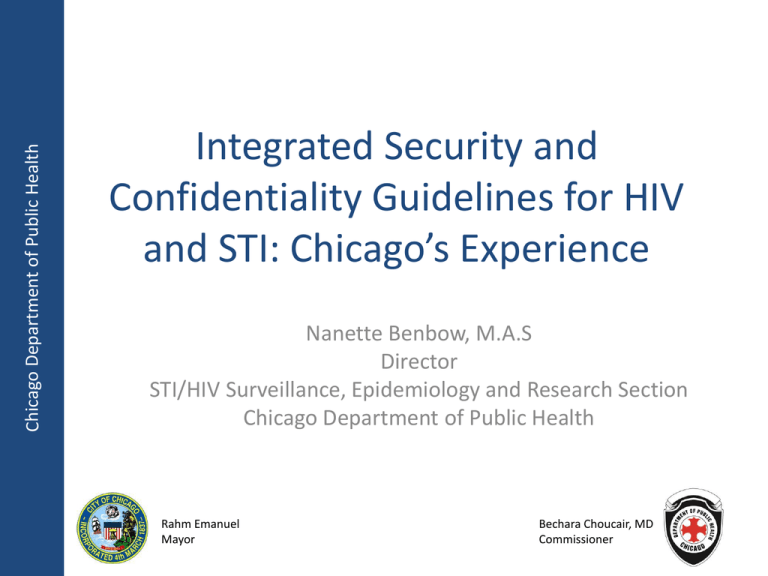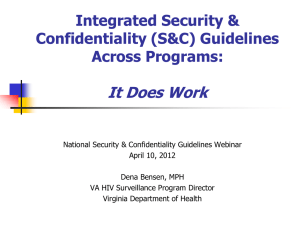Integrated Security and Confidentiality Guidelines for HIV and STI: Chicago’s Experience
advertisement

Chicago Department of Public Health Integrated Security and Confidentiality Guidelines for HIV and STI: Chicago’s Experience Nanette Benbow, M.A.S Director STI/HIV Surveillance, Epidemiology and Research Section Chicago Department of Public Health Rahm Emanuel Mayor Bechara Choucair, MD Commissioner Overview • • • • • Background Organizational Structure Need for integrated policies Process of developing integrated policies Program operation differences in security and confidentiality • Use of supplemental funds to develop, expand and improve policies • Conclusions Background • 1997 - Integrated STI/HIV Division • 2001 - HIV surveillance moved from Epidemiology Section to Communicable Disease Bureau • 2003 - HIV surveillance moved to STI/HIV Division – Integrated Surveillance, MMP, Incidence and NHBS • 2010 - Integrated STI/HIV Surveillance – HIV surveillance data matched with other diseases by HIV surveillance staff and findings shared in aggregate with other programs Organizational Structure Need for Integrated Policies • Same practices across programs within the Division • Importance of using HIV surveillance for disease control • Partner service’s use of HIV surveillance data on new positives • Identification of new positives for Expanded Testing Initiatives • Identifying linkage and retention in care • STI/HIV/TB co-infection analyses • TB program’s need to know HIV infection status of TB patients Process of Integration • Collaborated with STI surveillance staff , Director of Partner Services and Regional CDCI Supervisor • Develop shared language, expectations and commitment around security and confidentiality • Cross-walk HIV surveillance security and confidentiality guidelines with STI surveillance, partner services and TB programs’ operations (no guidelines available for other programs) • Identify differences in program practice and physical security that did not meet guidelines • Identify changes/compromises to draft integrated guidelines Key Differences (1) • Need to ensure their security and confidentiality procedures – TB and some STD data in state-administered database – HIV surveillance data in STD*MIS for partner services • Partner services using detailed HIV surveillance data out in the field • MMP and NHBS collect data on handhelds • GC&CT surveillance system can be accessed from any location with internet access Key Differences (2) • Physical space not amenable to be as restricted as HIV surveillance • Faxing of STI morbidity reports is a necessary and common practice • Field staff do not always have access to secure printers and faxes • Confidential information on STI could potentially be left on voice mail Items in CDC’s Guidelines Not Currently addressed in CDPH’s Policy • Be explicit regarding use of cell phones and personal digital assistants (PDAs) with cameras and/or video recorders in secure areas. • Address circumstances and procedures for remote work in the event of an emergency or outbreak response • Update confidentiality and security protocols to address migration from paper-oriented data to electronic devices that meet established and evolving electronic and procedural security standards for fieldwork • Mechanisms to share/transport confidential information electronically, e.g. sFTP Use of S&C Supplemental Funds (1) • Compared Security and Confidentiality Program Requirement Checklist with current practice of STI surveillance and Partner Services • Observed current practices and identified the following: – Systems/databases containing patient information (STD*MIS, C&T Database, INEDSS, etc) and current security measures needed to be modified or further investigated to meet requirements – Minimum data fields necessary to initiate HIV Partner Services to be entered into STD*MIS and mechanisms needed to share such data – Confidential information used in the field and document storage – Name and location of staff who have access to confidential information – Strengths and weaknesses of handling of confidential information and made recommendations to ensure compliance – Need for targeted training for field staff Use of S&C Supplemental Funds (2) Used HIV surveillance supplemental funds to: • Inform and develop content of training for field staff on new guidelines • Compare Security and Confidentiality Program Requirement Checklist with TB, Viral Hepatitis and Ryan White Program • Collaborate with Program Directors of other programs to define process and develop shared guidelines • Improve physical security of stored documents, including purchase of shredders, desk locks, and re-location of confidential information Conclusions • Integration of security and confidentiality policies is a process that requires: – Good communication and collaboration across programs at all levels – Time to identify differences in local program operations and resources – Time to develop a shared vision and implementation plan – National vision of combined security and confidentiality guidelines • New uses of secure and confidential surveillance and other programmatic data are constantly being developed which will require constant review and expansion of policies www.Cityofchicago.org/Health HealthyChicago@cityofchicago.org Facebook.com/ChicagoPublicHealth @ChiPublicHealth http://gplus.to/ChiPublicHealth (312) 747-9884


